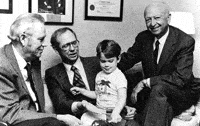
The Guide begins by explaining that hearing loss is the second most prevalent health problem that limits the functioning of people over age 65, then presents nine common objections to the purchase of hearing instruments, including “I can hear just fine,” “My friend got a hearing aid and she can’t stand it,” and “I can’t afford them.” Each objection is handled intelligently and respectfully (e.g., for the latter question, the response is: “Many people have concerns about the cost of the testing and the aid, the lack of insurance reimbursement and maintenance costs. Hearing aids can be a major expenditure, but many users find the costs well worth the improvement in quality of life.”)
The mechanics of the ear, the two major types of hearing loss (sensorineural vs. conductive) and common signs of hearing impairment are explained, along with the what steps consumers should take to check their hearing. The roles of hearing care professionals are delineated and the tests they commonly use are explained. Importantly, the Guide emphasizes that “Beyond the minimum skill and service provided to hearing aid clients, the ‘good’ dispenser focuses on being a health care provider rather than the seller of a product.” Other sections of the publication deal with the styles and technologies of hearing instruments, the advantage of binaural fittings, batteries, payment and warranty issues, aural rehabilitation, effective augmentative communication strategies and assistive devices. Additional consumer reference material is recommended, including Self-Help for Hard of Hearing People’s (SHHH) Getting the Most Out of a Visit to a Hearing Aid Specialist and Selecting a Hearing Aid (for information visit www.shhh.org.) and Richard Carmen’s Consumer Handbook on Hearing Loss & Hearing Aids (www.hearingproblems.com).
The Guide is not devoid of statements that may ruffle a few feathers in the dispensing community. For example, in some places it imparts a preference for audiologists. However, it’s important to note that all three hearing care disciplines are presented in a very positive light, and the Guide does an admirable job of emphasizing the vital role of hearing care professionals—whatever their title—in the hearing remediation process.
Another important fact that should not be lost on hearing care professionals is that the Guide represents a radical departure from AARP’s previous (1993) publication, A Report on Hearing Aids, that was critical of many aspects of the hearing care field. After reading the present Guide, consumers should have a better understanding of how to proceed thoughtfully and take good, well-reasoned actions in addressing their hearing problems—and they should be positively motivated to do so.
Copies of the Consumer Guide to Hearing Aids is available from AARP at no charge. For information, contact: AARP, 601 E Street, NW, Washington, DC 20049; tel: 800-424-3410; website: www.aarp.org. —KES




